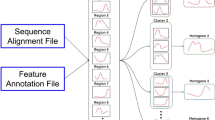Abstract
The Kendall correlation is a non-parametric method that measures the strength of dependence between two sequences. Like Pearson correlation and Spearman correlation, Kendall correlation is widely applied in sequence similarity measurements and cluster analysis. We propose an efficient algorithm, fastWKendall, to compute the approximate weighted Kendall correlation in \(O(n\log n)\) time and O(n) space complexity. This is an improvement to the state-of-the-art \(O(n^2)\) time requirement. The proposed method can be incorporated to perform conventional sequential similarity measurement and cluster analysis much more rapidly. This is important for analysis of huge-volume datasets, such as genome databases, streaming stock market data, and publicly available huge datasets on the Internet. The code which is implemented in R is available for public access.





Similar content being viewed by others
References
Amerise IL, Tarsitano A (2016) Combining dissimilarity matrices by using rank correlations. Comput Stat 31(1):1–15
Campello RJGB, Hruschka ER (2009) On comparing two sequences of numbers and its applications to clustering analysis. Inf Sci 179(8):1025–1039
Cerro JC, Cerdà V, Pey J (2015) Trends of air pollution in the Western Mediterranean Basin from a 13-year database: a research considering regional, suburban and urban environments in Mallorca (Balearic Islands). Atmos Environ 103:138–146
Chan CH, Yan F, Kittler J, Mikolajczyk K (2015) Full ranking as local descriptor for visual recognition: a comparison of distance metrics on \(s_n\). Pattern Recognit 48(4):1328–1336
Christensen D (2005) Fast algorithms for the calculation of Kendall’s \(\tau \). Comput Stat 20(1):51–62
Coolenmaturi T (2014) A new weighted rank coefficient of concordance. J Appl Stat 41(41):1721–1745
Coolenmaturi T (2016) New weighted rank correlation coefficients sensitive to agreement on top and bottom rankings. J Appl Stat 43(12):1–19
Costa JPD, Roque LAC, Soares C (2015) The weighted rank correlation coefficient \(r_{W2}\) in the case of ties. Stat Probab Lett 99:20–26
Etesami O, Gohari A (2016) Maximal rank correlation. IEEE Commun Lett 20(1):117–120
Fenwick PM (1994) A new data structure for cumulative frequency tables. Softw Pract Exp 24(3):327–336
Goodman LA, Kruskal WH (1954) Measures of association for cross classifications. J Am Stat Assoc 49(268):732–764
Jaskowiak PA, Campello RJ, Costa IG (2014) On the selection of appropriate distances for gene expression data clustering. BMC Bioinform 15(Suppl2):390–400
Kendall MG (1938) A new measure of rank correlation. Biometrika 30(3):81–93
Marden JI, Kendall M, Gibbons JD (1992) Rank correlation methods (5th ed.). J Am Stat Assoc 87(417):249
Melucci M (2009) Weighted rank correlation in information retrieval evaluation. In: Asia information retrieval symposium on information retrieval technology, pp 75–86
Okada C, Yugo S, Torres RDS (2015) Unsupervised distance learning by rank correlation measures for image retrieval. In: ACM on international conference on multimedia retrieval, pp 331–338
R Core Team (2015) R: a language and environment for statistical computing. R Foundation for Statistical Computing, Vienna, Austria. https://www.R-project.org/
Shieh GS (1998) A weighted Kendall’s tau statistic. Stat Probab Lett 39(1):17–24
Slotta DJ (2005) Evaluating biological data using rank correlation methods. PhD thesis, Virginia Polytechnic Institute and State University
Stepanov A (2015) On the Kendall correlation coefficient. arXiv:1507.01427 [math.ST]
Tarsitano A (2005) Weighted rank correlation and hierarchical clustering. In: Zani S, Cerioli A, Riani M, Vichi M (eds) Book of short papers of CLADAG 2005. Springer, Palermo, pp 517–521
Wilbik A, Keller JM, Bezdek JC (2014) Linguistic prototypes for data from eldercare residents. IEEE Trans Fuzzy Syst 22(1):110–123
Acknowledgements
This work is supported by the Chinese National Natural Science Foundation (Grant No. 61472082), Natural Science Foundation of Fujian Province of China (Grant No. 2014J01220), Scientific Research Innovation Team Construction Program of Fujian Normal University (Grant No. IRTL1702) and the US National Science Foundation (Grant No. IIS-1552860).
Author information
Authors and Affiliations
Corresponding author
Electronic supplementary material
Below is the link to the electronic supplementary material.
Rights and permissions
About this article
Cite this article
Lin, J., Adjeroh, D.A., Jiang, BH. et al. fastWKendall: an efficient algorithm for weighted Kendall correlation. Comput Stat 33, 1823–1845 (2018). https://doi.org/10.1007/s00180-017-0775-6
Received:
Accepted:
Published:
Issue Date:
DOI: https://doi.org/10.1007/s00180-017-0775-6




